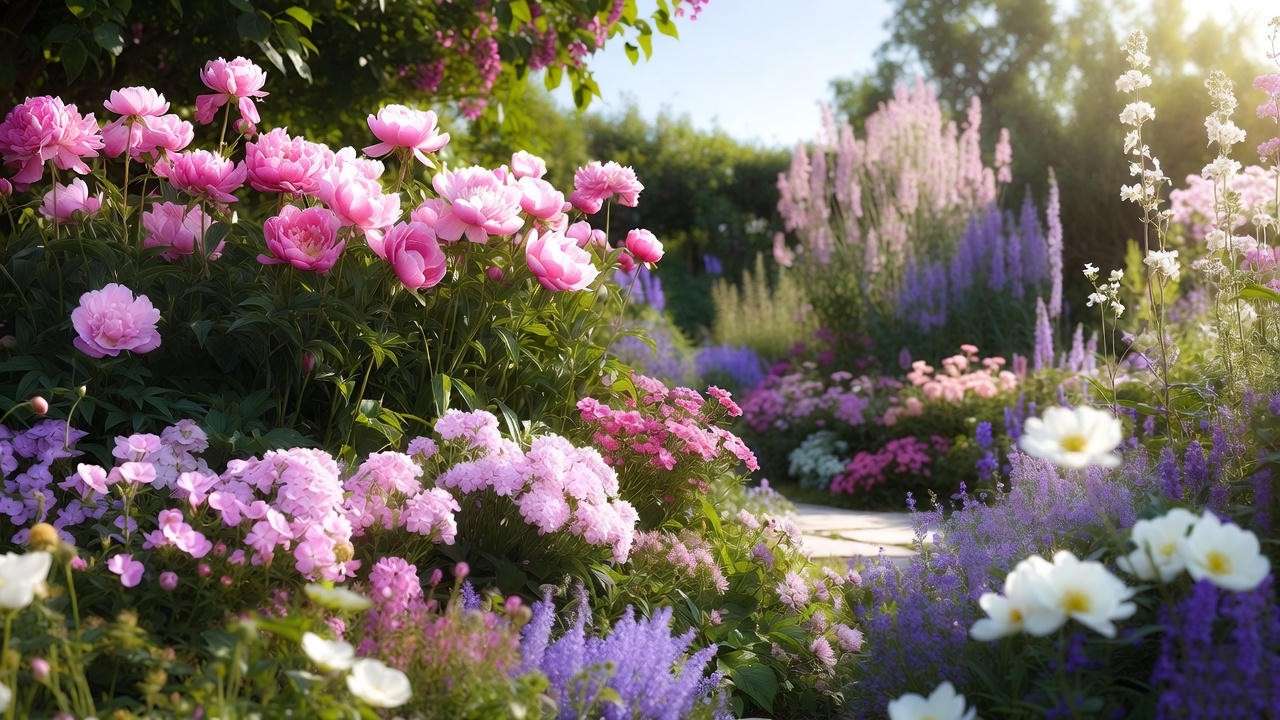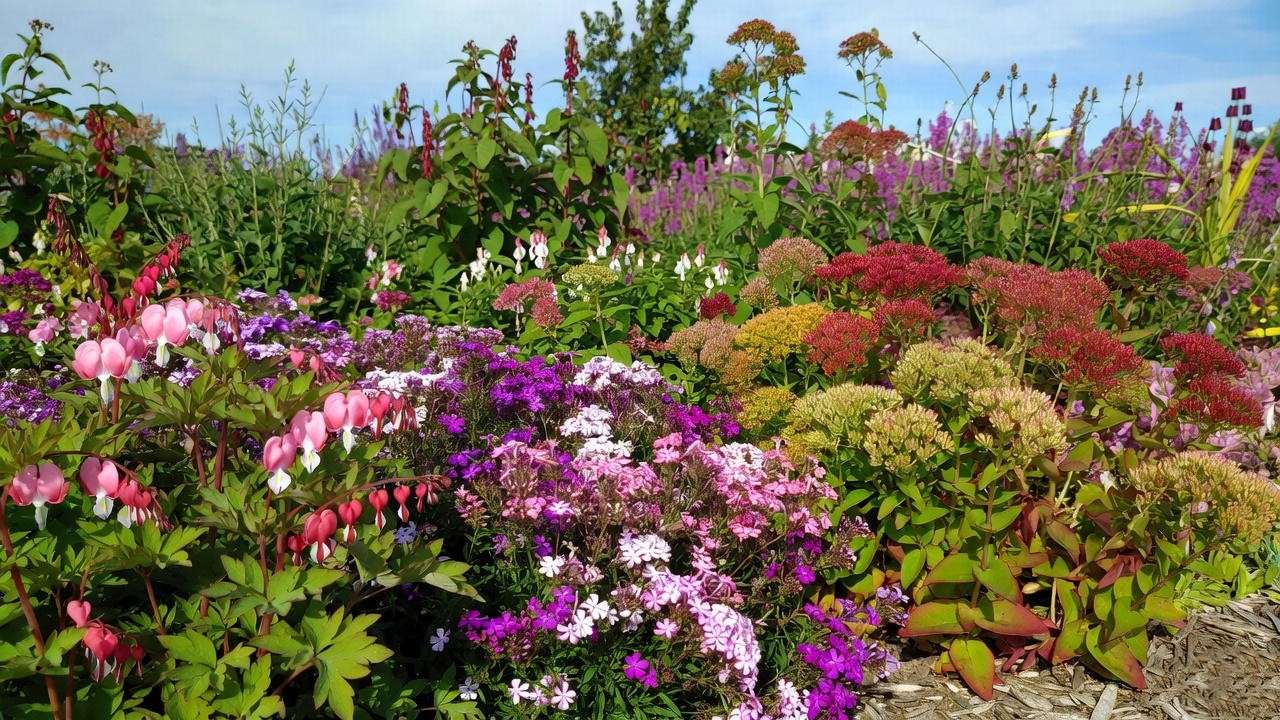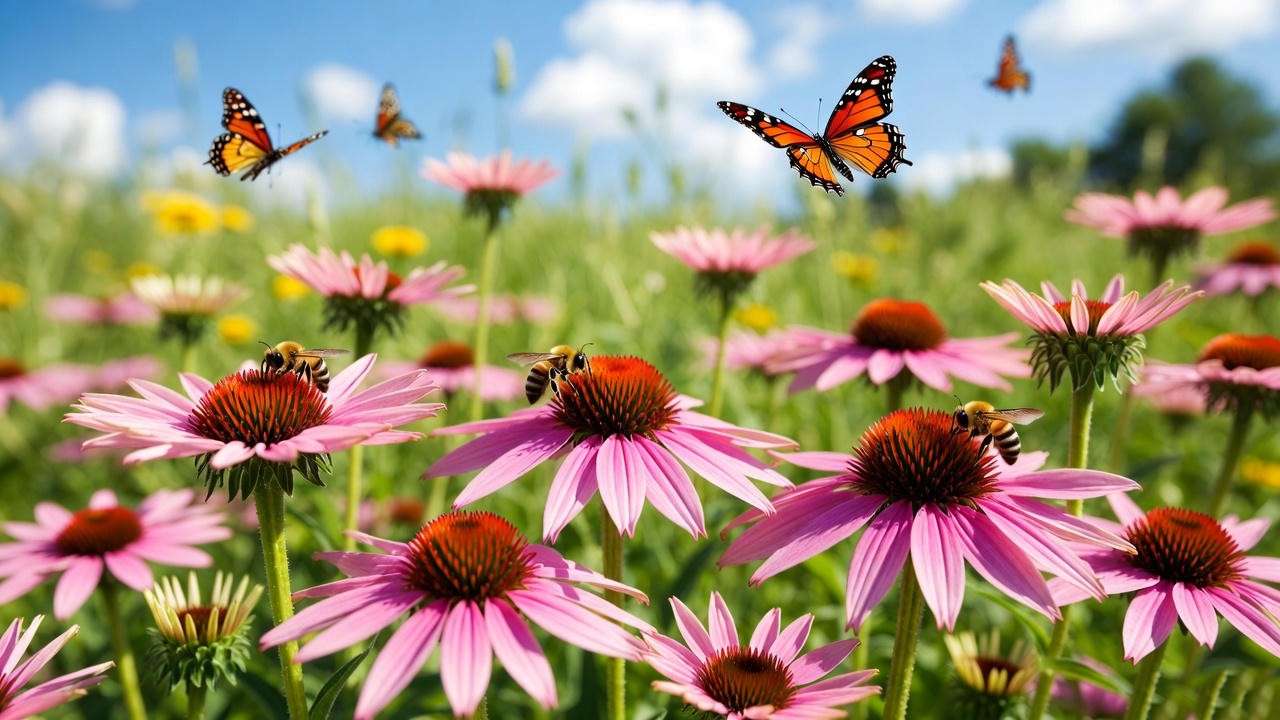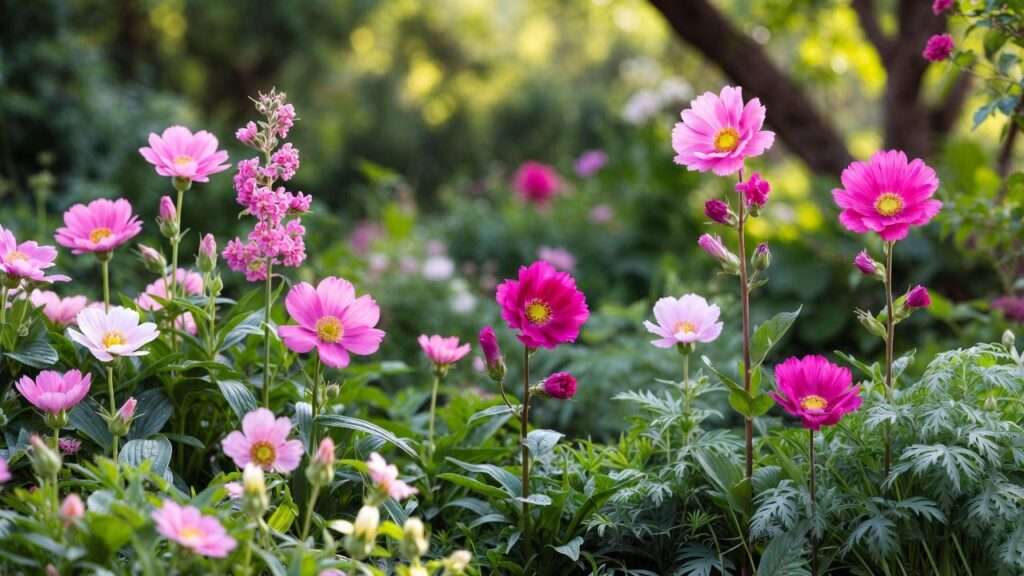Picture this: a garden bursting with delicate pink blooms that return year after year, transforming your outdoor space into a vibrant, low-maintenance haven. If you’re searching for perennial plants pink to elevate your garden’s charm, you’re in the right place! Pink perennials are a gardener’s dream, offering stunning color, easy care, and eco-friendly benefits. As a horticulturist with over a decade of experience designing sustainable gardens, I’ve curated the top 10 pink perennials to help you create a show-stopping landscape. This guide provides expert care tips, design ideas, and practical advice to solve your gardening challenges, whether you’re a beginner or a seasoned green thumb. Let’s dive into the world of pink perennials and discover how to make your garden glow! 🌿
Why Choose Perennial Plants Pink for Your Garden? 🌼
Pink perennials are more than just pretty flowers—they’re a smart choice for gardeners seeking beauty and practicality. Let’s explore why these plants are a must-have for your outdoor space.
The Appeal of Pink in Garden Design
Pink flowers bring a unique blend of elegance and energy to any garden. Their soft hues evoke feelings of calm and romance, while bolder shades like magenta add a vibrant pop. Pink perennials pair beautifully with purples, whites, and blues, creating harmonious color schemes. For example, planting pink peonies alongside lavender creates a dreamy cottage garden vibe. According to garden design principles, pink acts as a versatile bridge between warm and cool tones, making it ideal for cohesive landscapes.
Benefits of Perennial Plants
Perennials are the backbone of sustainable gardening. Unlike annuals, which need replanting each year, perennials return season after season, saving you time and money. They’re low-maintenance, requiring less water and care once established, and many are drought-tolerant, making them eco-friendly choices. Perennials like coneflowers and bee balm also attract pollinators such as bees and butterflies 🦋, supporting local ecosystems. The Royal Horticultural Society notes that perennials are increasingly popular for their longevity and environmental benefits, making them a top choice for modern gardeners.
Why Pink Perennials Are a Must-Have
Pink perennials offer unmatched versatility. They thrive in various settings—borders, containers, or as focal points—and provide extended blooming periods for seasonal interest. Whether you’re tackling a small urban garden or a sprawling backyard, these plants deliver vibrant color with minimal upkeep. For gardeners seeking solutions to high-maintenance landscapes, pink perennials are the answer, combining aesthetic appeal with practicality.
Top 10 Perennial Plants Pink for Your Garden 🌷
Here’s our expertly curated list of the top 10 pink perennials, complete with descriptions, care tips, and design ideas to inspire your garden. Each plant has been selected for its beauty, ease of care, and ability to thrive in diverse climates.
1. Peony (Paeonia) – The Romantic Classic
Description: Peonies are the epitome of elegance, with lush, full blooms in shades ranging from soft blush to vibrant magenta. These iconic flowers are a favorite for their luxurious appearance and sweet fragrance.
Growing Conditions: Full sun, well-drained soil, USDA zones 3-8.
Care Tips: Water regularly during the first year to establish roots. Deadhead spent blooms to keep plants tidy, and divide every 3-5 years to maintain vigor. Mulch in winter to protect roots in colder climates.
Design Idea: Use peonies as a focal point in cottage gardens or pair with low-growing perennials like catmint for contrast.
Expert Tip: The ‘Sarah Bernhardt’ variety, with its pale pink double blooms, is a timeless choice for romantic garden designs.

2. Coneflower (Echinacea) – The Pollinator’s Delight 🐝
Description: Coneflowers feature bold pink petals surrounding a spiky copper center, creating a striking visual effect. These hardy plants are a magnet for pollinators.
Growing Conditions: Full sun, drought-tolerant, USDA zones 3-9.
Care Tips: Once established, coneflowers need minimal watering. Prune in late winter to encourage new growth. Avoid over-fertilizing, as it can reduce blooming.
Design Idea: Plant in clusters for a prairie-style garden or mix with ornamental grasses for texture.
Fun Fact: Studies from the USDA confirm that Echinacea supports pollinator populations, making it a must for eco-conscious gardeners.
3. Phlox (Phlox paniculata) – The Summer Showstopper
Description: Garden phlox produces clusters of star-shaped pink flowers with a sweet, lingering fragrance, blooming profusely in summer.
Growing Conditions: Full sun to partial shade, moist but well-drained soil, USDA zones 4-8.
Care Tips: Ensure good air circulation to prevent powdery mildew, a common issue. Water consistently and deadhead to extend blooming.
Design Idea: Use phlox in borders or mixed beds alongside daylilies for a vibrant summer display.
Expert Insight: The ‘Bright Eyes’ cultivar, with its soft pink blooms and crimson centers, adds drama to any garden.
4. Dianthus (Dianthus spp.) – The Fragrant Groundcover
Description: Dianthus, or pinks, are compact plants with spicy-scented pink blooms, perfect for small spaces. Their gray-green foliage adds year-round interest.
Growing Conditions: Full sun, well-drained soil, USDA zones 3-9.
Care Tips: Shear plants after blooming to encourage reblooming. Avoid overwatering, as dianthus prefers slightly dry conditions.
Design Idea: Use as edging along pathways or in rock gardens for a tidy, colorful border.
Pro Tip: The ‘Firewitch’ variety is a standout for its vivid magenta flowers and long bloom time.
5. Astilbe – The Shady Pink Star
Description: Astilbe’s feathery pink plumes add a soft, airy texture to shaded gardens, blooming in early to mid-summer.
Growing Conditions: Partial to full shade, moist soil, USDA zones 4-8.
Care Tips: Keep soil consistently moist, especially in warmer climates. Mulch in winter to protect roots. Divide every 3-4 years.
Design Idea: Pair with hostas or ferns for a lush, woodland-inspired garden.
Expert Insight: Astilbe ‘Visions in Pink’ offers compact growth and vibrant blooms, ideal for small shady spaces.

6. Yarrow (Achillea millefolium) – The Drought-Tolerant Beauty
Description: Yarrow boasts flat clusters of pink flowers atop fern-like foliage, offering a delicate yet hardy addition to sunny gardens. Its blooms range from soft pink to coral.
Growing Conditions: Full sun, well-drained soil, USDA zones 3-9.
Care Tips: Yarrow is low-maintenance and drought-tolerant once established. Divide every 2-3 years to prevent overcrowding and maintain vigor. Deadhead to encourage continuous blooming.
Design Idea: Incorporate yarrow into xeriscaping designs or sunny borders alongside lavender for a Mediterranean flair.
Expert Tip: The ‘Pink Grapefruit’ cultivar delivers vibrant pink blooms that fade gracefully, adding multi-seasonal interest.
7. Bleeding Heart (Dicentra spectabilis) – The Heart-Shaped Charmer 💖
Description: Bleeding heart’s dangling, heart-shaped pink flowers create a whimsical spring display, perfect for romantic gardens. Its fern-like foliage adds texture.
Growing Conditions: Partial to full shade, rich, moist soil, USDA zones 3-9.
Care Tips: Protect from hot afternoon sun and water regularly to keep soil moist. Plants may go dormant in summer; mark their location to avoid disturbing roots.
Design Idea: Plant under trees or in shaded borders with columbines for a charming woodland effect.
Fun Fact: The ‘Valentine’ variety features deep pink hearts with white tips, a favorite for spring gardens.
8. Sedum (Sedum spectabile) – The Late-Season Star
Description: Sedum, or stonecrop, offers succulent foliage topped with clusters of star-shaped pink flowers in late summer to fall, extending your garden’s bloom season.
Growing Conditions: Full sun, well-drained soil, USDA zones 3-9.
Care Tips: Sedum thrives with minimal water and care. Prune in spring to encourage bushy growth. Avoid heavy, wet soils to prevent root rot.
Design Idea: Use in rock gardens or as a border accent with ornamental grasses for a modern look.
Expert Insight: ‘Autumn Joy’ is a classic variety with pink blooms that deepen to bronze, offering stunning fall color.
9. Bee Balm (Monarda) – The Hummingbird Magnet 🐦
Description: Bee balm’s spiky pink blooms and minty fragrance attract hummingbirds and pollinators, making it a lively addition to summer gardens.
Growing Conditions: Full sun to partial shade, moist soil, USDA zones 4-9.
Care Tips: Divide every 3 years to prevent overcrowding and promote airflow, reducing powdery mildew risk. Water regularly during dry spells.
Design Idea: Plant near patios or seating areas to enjoy hummingbird visits and the plant’s aromatic foliage.
Pro Tip: The ‘Raspberry Wine’ cultivar offers rich pink flowers and excellent disease resistance.
10. Rose Campion (Lychnis coronaria) – The Silvery Pink Gem
Description: Rose campion’s vivid pink flowers contrast beautifully with its silvery-gray foliage, creating a striking visual effect. It’s a self-seeding perennial that adds charm effortlessly.
Growing Conditions: Full sun, well-drained soil, USDA zones 4-8.
Care Tips: Deadhead to extend blooming and control self-seeding if desired. Tolerates poor soils and drought once established.
Design Idea: Use in Mediterranean-style gardens or as a border plant with salvia for a bold color contrast.
Expert Insight: Its woolly foliage resists deer, making it ideal for gardens with wildlife challenges.
How to Care for Pink Perennials: Expert Tips for Success 🌱
To ensure your pink perennials thrive, follow these expert care tips tailored to their unique needs. Proper planting, watering, and maintenance will keep your garden vibrant for years.
Planting Pink Perennials
Timing is key for successful perennial planting. Early spring or fall is ideal, allowing roots to establish before extreme weather. Prepare the soil by adding organic matter like compost to improve drainage and fertility. Follow plant-specific spacing guidelines—crowded plants compete for nutrients and are prone to disease. For example, peonies need 3-4 feet of space, while dianthus can be planted closer together. Test your soil’s pH, aiming for a neutral range (6.0-7.0) for most perennials, as recommended by the USDA.
Watering and Fertilizing
Watering needs vary by plant, but most pink perennials prefer consistent moisture during their first year. Once established, drought-tolerant varieties like yarrow and sedum require minimal watering, while astilbe and bleeding heart thrive in moist conditions. Use a balanced, slow-release fertilizer (e.g., 10-10-10) in spring to boost growth. Avoid over-fertilizing, which can lead to leggy growth and fewer blooms. I’ve seen gardeners achieve stunning results by applying a thin layer of compost annually instead of synthetic fertilizers.
Pruning and Maintenance
Regular maintenance keeps pink perennials healthy and attractive. Deadhead spent blooms to encourage reblooming and maintain a tidy appearance—phlox and dianthus respond particularly well to this. Divide overcrowded plants every 3-5 years to promote vigor; spring or fall is best for this task. In colder climates (USDA zones 3-5), mulch plants in late fall to protect roots from freezing. For example, a 2-inch layer of straw or bark mulch works wonders for peonies and coneflowers.
Common Pests and Diseases
Pink perennials are generally hardy but can face issues like aphids, powdery mildew, and root rot. Aphids, common on phlox and bee balm, can be controlled with neem oil or insecticidal soap. Powdery mildew, a risk for phlox, is preventable with good air circulation and proper spacing. Ensure well-drained soil to avoid root rot, especially for astilbe and bleeding heart. Regular inspection, as I practice in my own garden, catches problems early, minimizing damage.
Designing a Pink Perennial Garden: Ideas and Inspiration 🎨
A well-designed garden showcases pink perennials’ beauty while ensuring year-round interest. Here’s how to create a stunning landscape with these vibrant plants.
Creating a Color Palette
Pink perennials shine when paired with complementary colors. Soft pinks, like those of peonies, blend beautifully with purples (lavender, salvia) and whites (shasta daisies). Bolder pinks, like coneflowers, pop against blues (delphinium) or yellows (coreopsis). For a romantic border, combine ‘Sarah Bernhardt’ peonies with lavender and white phlox. Use foliage plants like hostas or silvery rose campion to add texture and contrast, creating a balanced, visually appealing design.

Layout and Structure
Structure your garden for impact by layering plants by height. Place taller perennials like peonies or bee balm at the back of borders, mid-height plants like phlox or coneflowers in the middle, and low-growers like dianthus or yarrow at the front. Create focal points with bold plants—coneflowers make excellent centerpieces in circular beds. Incorporate evergreens or ornamental grasses for year-round structure. For small spaces, use containers with dianthus or astilbe to add pink pops without overwhelming the area.
Seasonal Interest
Plan for continuous blooms to keep your garden vibrant. Early bloomers like bleeding heart kick off spring, followed by mid-summer stars like phlox and bee balm. Late-season sedum and yarrow extend color into fall. For example, a garden bed with bleeding heart, phlox, and sedum ensures blooms from April to October. Add bulbs like tulips for early spring color or evergreens for winter interest, creating a dynamic, multi-seasonal garden.

Why Pink Perennials Are Eco-Friendly 🌍
Pink perennials aren’t just beautiful—they’re good for the planet. Plants like coneflowers and bee balm attract pollinators, supporting biodiversity. The Xerces Society highlights that native perennials like Echinacea are critical for declining bee populations. Drought-tolerant options like yarrow and sedum conserve water, making them ideal for sustainable landscapes. By choosing pink perennials, you’re creating a garden that’s both stunning and environmentally responsible.

FAQs About Perennial Plants Pink ❓
What are the easiest pink perennials to grow?
Yarrow, sedum, and dianthus are low-maintenance and perfect for beginners due to their drought tolerance and minimal care needs.
Can pink perennials grow in shade?
Yes, astilbe and bleeding heart thrive in partial to full shade, making them ideal for woodland or shaded gardens.
How do I keep pink perennials blooming longer?
Deadhead regularly, provide adequate water, and fertilize lightly in spring to encourage extended blooming.
Are pink perennials good for small gardens?
Compact varieties like dianthus and rose campion are excellent for small spaces, offering vibrant color without overwhelming the area.
Conclusion: Transform Your Garden with Pink Perennials 🌸
Pink perennials are the perfect blend of beauty, ease, and sustainability, making them a top choice for gardeners of all levels. From the romantic peony to the pollinator-friendly coneflower, these plants deliver vibrant color with minimal effort. Use our expert tips to plant, care for, and design a stunning pink perennial garden that blooms year after year. Start planning today—your dream garden is just a few plants away! Share your favorite pink perennial in the comments or try our suggested garden plan for a vibrant, low-maintenance landscape. 🌷













